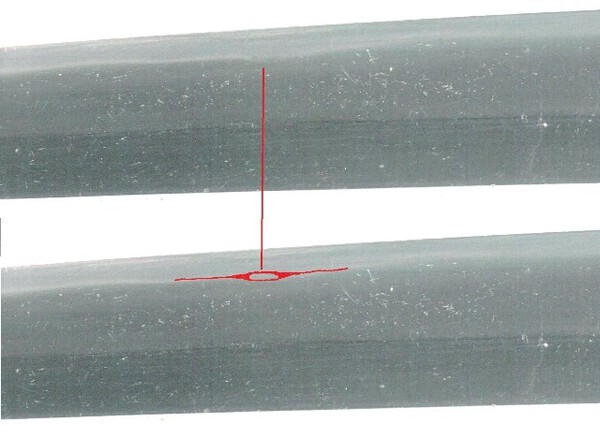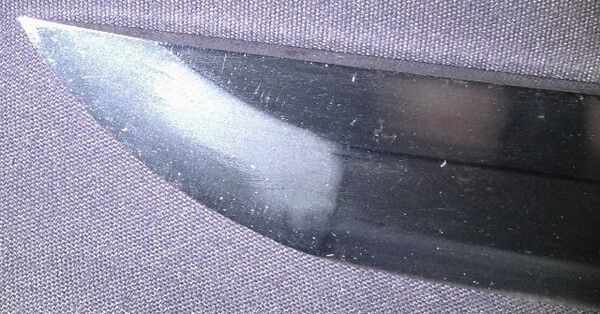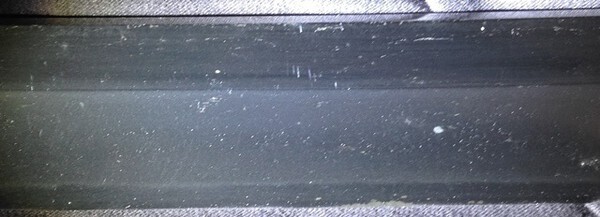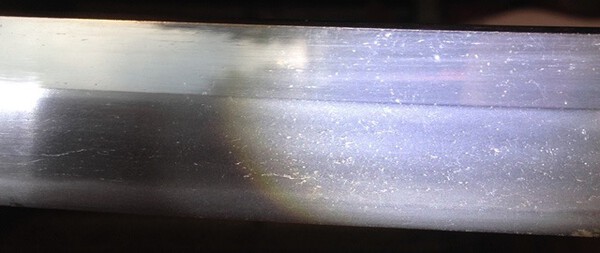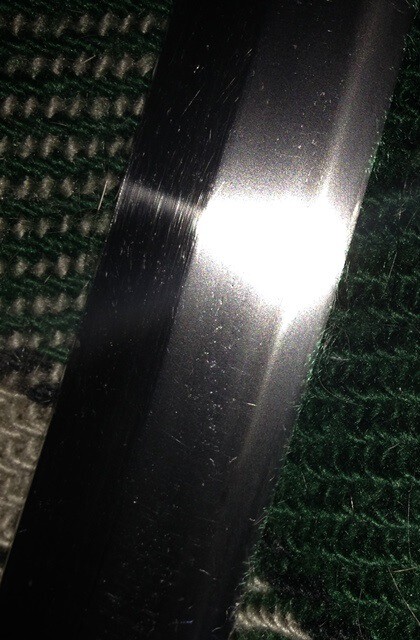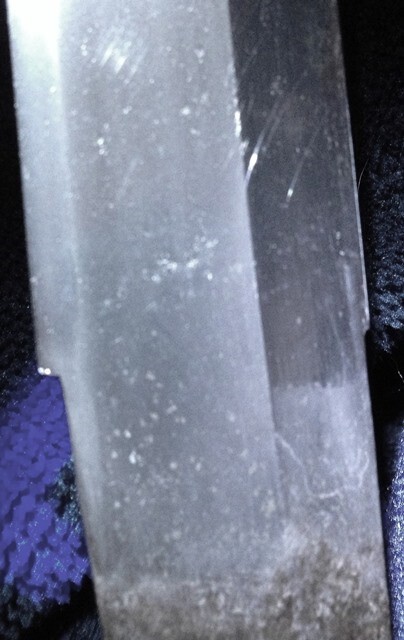-
Posts
1,963 -
Joined
-
Last visited
-
Days Won
5
Content Type
Profiles
Forums
Events
Store
Downloads
Gallery
Everything posted by Mark S.
-
All, Thank you for the info so far and I will continue the research. Missed the last Chicago shinsa 2 shows ago... can't wait for the next one. N1001, the write up you gave me was from the Zenjo Kaneyoshi Uchigatana info I saw on line as well. Thank you. It was one of the references I read with great interest. Until the next shinsa I was just looking for more info. I've never seen what a typical 'fuschi knot / bump' looks like in person, so I am going off the person's knowledge that looked at the blade as well as what I can find on line and in my books. I thank you all for your input. Mark S.
-
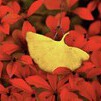
Realistically, How Likely Is It...
Mark S. replied to Chango's topic in General Nihonto Related Discussion
Hate to be the one to break it to you... but gimei... OK... Someone had to... -
At the recent Chicago show, I was given some advice from several people on a mumei wakizashi I purchased a while back. One of the more interesting attributions I was encouraged to investigate was the Mino Seki Zenjo (Zenjyo?) school, Muromachi Era. I have read several different references to two Mino schools (Zenjo - Kaneyoshi seems to be the prominent smith - and the Kanesada school) that identify a very tight distinct nioi-guchi suguha along with a single small ‘bump’ of fuschi or midare (irregularity) somewhere in the suguha… and it was ONE (of several) of the kantei points that was pointed out to me as the reason the person gave me their attribution. Personally, I never would have noticed it without this person’s expert advice and appreciate the time taken to inspect the blade long enough to find it. Due to the state of polish and my poor photo skills, activity is difficult to capture. However, I managed to capture the ‘‘bump’ of fuschi or midare (irregularity) on a scan of the blade. To make it easier to find, I highlighted the area in red on the bottom copy in one of the attached pics. In an effort to learn more (I am not doubting the advice given to me about steering more toward the Zenjo attribution), I was just wondering if anyone has any additional information about this kantei point, the schools, or smiths. I do realize that a shinsa may only give a general “Mino Seki” attribution to the blade… and at best possibly a “Den” attribution to one of the schools, and probably not a particular smith, but I’m just interested if there is any more info out there that might help narrow things down a bit, or if others have blades with similar properties. Wakizashi Information Nagasa: 17-5/8” Sori: 3/8” Kissaki: 1-3/16” Nakago: 6-1/2” Ubu or slightly suriage, kiri-jiri, kiri yasurime Mekugi-ana: 1 Hamon: Very tight distinct nioi-guchi suguha. About 4” from the tip of the kissaki along the suguha there is a single small ‘bump’ of fuschi or midare? (irregularity). Hada: very fine grain - masame? Difficult to see and photograph due to state of polish. Some masame-hada (I believe) appears in the shinogi-ji Boshi: Hakikake or kaen? Thanks, Mark S.
-

Chicago Sword Show
Mark S. replied to Derek's topic in Sword Shows, Events, Community News and Legislation Issues
And another side note... if your heart wasn't warmed when you were greeted at the entrance table by who has to be the youngest and newest member of the group... I couldn't help but smile... -

Chicago Sword Show
Mark S. replied to Derek's topic in Sword Shows, Events, Community News and Legislation Issues
Went to the show on Saturday. Ortho doctor probably won't be pleased as I was the guy hobbling around in an ankle boot due to a fractured ankle bone. Oh well, 6 hours of roaming around HAS to be good for it... right? Anyway, a great show from my point of view. Always meet some great people, see and touch things I would never see, learn a lot of new things, and usually try something new... and covet many, many things. This year for the first time, I sat in on the tosogu kantei presentation by Mike Yamasaki. I have to admit, I thought it was going to be Mike teaching kantei points (which he did), but I didn't realize I would be at a table as part of a kantei team!!! It only took a few minutes to realize I was in WAY over my head and was kinda looking for a quick and graceful exit... but then thought "what the heck". The knowledge of the gentlemen at my table was amazing (as was their patience). While I tried to comment when I was comfortable, I usually went the old adage of not proving my ignorance by opening my mouth too often, and actively listening to those who could teach me. A well done session on every level. Biggest take aways were were: 1) not everything is as it seems, and 2) being a part of a kantei team is no easy task and I have a different perspective for what they must go through. I also brought along a wakizashi I purchased a while back to get a few opinions on. Several gentlemen gave their opinions/advice and I am grateful for the input. It is no 'national treasure' for sure, but I have some leads to research. I kinda joked that 'it got called every name in the book' (and in every way too)! Once again, a special 'thank you' to Mike Yamasaki for his input on the blade and for the extra time he took to answer my questions both at the kantei session and when evaluating the blade. I received my own mini kantei session on the blade. He was generous with his time and knowledge, as were several other people, and I am grateful to all. I have learned over the years of attending the shows that different people have different 'styles' of communication. It can be a bit daunting at times, especially for a newbie... but my only advice is that if you are new, accept ALL advice no matter how it is given... smile and learn... some lessons are tougher than others... and don't be afraid to ask several opinions. Overall, I had a wonderful day. As with many I am sure, money was tight this year, so I had to limit myself to a DVD purchase (Death of a Tea Master). Hope to save up for a purchase at next year's show. Saw too many things I wanted. A kid in a candy store day! I am truly fortunate to have this wonderful resource in literally 'my back yard' as I live only a few miles away. GREAT SHOW! Mark S. -

Chicago Sword Show
Mark S. replied to Derek's topic in Sword Shows, Events, Community News and Legislation Issues
I live only 15 minutes away from the hotel... so I will be there... -
Right there with you... have tried to pull the "Wow, isn't that a nice tsuba" with my wife a couple of times... she isn't taking the hint... and is smart enough to know better!
-
Sorry... I dislike trying to post from a phone, but I'll try even though we are going to have to play a bit of 'Battleship' to reference the proper info... Only have one symbol so far, on the front of the tsuba just below the kozuka hitsu-ana, I think it can be found on the fourth chart of Brian's post, 9th row down, 5th column over. Looks like the kanji for "Wa" or Harmony? Mark S.
-
A bit late to this one, but may I suggest the book in the attached picture? It is a month by month Chado Almanac that is a wealth of information that extend way beyond the tea ceremony. Monthly themes, flowers, food, words, etc. At 792 pages, it is quite extensive. I was lucky enough to pick one up several years ago for about $10... but I see the price has gone up considerably. There is a Kindle version for $18. Hope it helps, Mark S.
-
Unknown. Blade is mumei and I wasn't able to include it in the Shinsa at the show. Hope NTHK returns to Chicago again. Here are some of my best guesses right now: maybe late Muromachi? maybe one of the later Mihara? maybe Yamato tradition? maybe Den Tadayoshi? maybe Bizen? Unfortunately, nakago has some issues with what looks like a previous cleaning attempt (some of the old patina is there and the file marks are visible - just scratched up a bit in the opposite direction) and the polish is old. All that and my inability to get good photos stopped me from just doing the 'posting of bad photos and asking for a kantei here' kinda thing. If you still want me to try to get better photos or want more info, let me know.
-
All, Picked up a wakizashi a few months ago at the Chicago Show. After many attempts, got a few pictures of the boshi that show the activity. Had to play with a few of the settings to get it to show better, but I think there is enough there to see... a very difficult part of the sword to photograph. Would I be correct in labeling the activity of the boshi as hikkake? In the second picture, there appears to be almost an 'eye' in the center of the activity. Rest of the blade has a suguha hamon and a pretty tight itame (I think) hada. Due to state of polish, it's a little difficult to tell. Any comments would be appreciated. Thanks, Mark S.
-
Probably not what you are looking for, but from Nakahara: "The less common so-no-mune [maru-mune] was thought of in the past... as not being used in the five traditions (that is, Yamashiro, Yamato, Bizen, Soshu, Mino). However, exceptions by the top-ranked smiths of the Soshu tradition (Shintogo Kunimitsu school, Masamune, and Sadamune) have been discovered in the form of swords offered to shrines." And then later he writes, "Rounded mune may be seen among the works of smiths of Chikuzen no Kuni Kongobei, Satsuma no Kuni Naminohira, and Mutsu no Kuni Gassan."
-
Not trying to beat a dead horse, but it would be nice if an attribution is made, then a reason 'why' would be given. Last year I purchased a mumei Kai-Mihara katana that was given an attribution (in so many words) of "Den Bingo Kai-Mihara Masamori - Tensho era" by the NTHK-NPO in 2011. But while I have found a listing for the swordsmith, I still don't know WHY the Shinsa team felt strongly enough to attribute the style of mumei blade to this smith. They must have seen 'something' that made them single out this smith vs just listing the school/period, but I haven't found out much info about him, so I can't say he would be considered 'famous'. In no way do I question the shinsa team, but it would be nice to at least be able to know 'why'.
-
We must keep in mind that the true measure of a chawan is how well one can make a perfect bowl of tea (especially koicha) for the pure enjoyment of one's guest... but I digress from the discussion of the bowl as art. Just thought there wasn't enough controversy in this thread... still have to learn how to add a smiley when posting from iphone... Mark S.
-
Both are signed Kunihiro... but in different ways (the way the kanji are engraved). Could it be the same smith made both... but signed differently? If not, what are the odds two different Kunihiro's would end up on the same koshirae? Other possibilities?
-
Thanks for the hint... after looking at a few more examples I 'think' I have the three characters above Kunihiro. Once again, like the Kuni, it seems the 'Fuji' is a bit more simplified than some of the examples I saw. ? ? ? kami Fujiwara Kunihiro
-
The following pictures are from another military gun/surplus site and the owner is asking for help. It also gives me a chance to practice my VERY limited translation skills... such as they are. Tsuba: I believe second character in mei is 'Hiro'? I thought first character would be easy to find... but couldn't. Is it an abbreviated 'Kuni'? Kogatana: Am I (again) seeing Kunihiro as last two characters? The rest was a bit beyond me. Thank you in advance Mark S.
-
Hope I don't do anything 'wrong' by posting this (and hope it hasn't been discussed before), but if so, please remove... I was just browsing e-bay, and came across this blade... http://www.ebay.com/itm/Antique-Old-Jap ... 1e902f5b64 I started with just wanting to translate the mei for practice and I came up with Harima Fujiwara Tadakuni...??? Hopefully got that part right. Not sure if gimei or not... THAT I leave to the experts... Mark S.
-
Regarding an ubu mumei Kai-Mihara katana (I posted about a while ago) with both Kosh-hi on the omote side and Gomabashi on the ura side, here is where I start wondering if I just have wishful thinking... but two quotes from the above website: "In medieval Japan, when a smith makes a blade for some god or Buddha, he tries to make a best blade, but no will to put his signature on the tang. He refrains from putting his signature on the holy thing that will offer in shrine or temple. When the smith gets an order from some high class lord, he takes the same way. It is a manner to respect the objects humbling the smith himself... The originally unsigned blades with good quality would be made by such situation. Probably they were made for some god or Buddha, or by order from high class person." AND in combination with (from same website): "Koshi-hi (short groove) This is a short groove with rounded top. Usually it suggests the sword of the Buddha "Fudo-myo'o". Its meaning is the same to the engraving "Ken" that is the symbol of power of Buddha. Sometimes Koshi-hi can mean any Buddha. It is the most simple symbol of prayers. It is not a decoration, so it must appear on one side of the blade. Hashi or Goma-bashi (chopsticks) This is double narrow short grooves with the same length and rounded top. These are symbol of chopsticks that used for a Buddhism ceremony. So they also mean a power of Buddha. Combination of grooves Bo-hi or Futasuji-hi doesn't have any special meaning by them selves. When they appear on each side of blade, it can have a meaning of prayer. They may suggest a Buddha and his two valets. A main Buddha with two second Buddhas is common motif in Buddhist images." In my blade's case, could it point to an order from a shrine/temple... or a 'high ranking' person with deeply held religious beliefs... or other...? Of course we will never know... and sometimes a little information (as above) put together can lead to some pretty wild 'guesses'... but a man can dream... Mark S.
-
The change in lighting cleared up things on the nakago... but the poor blade has seen better days.
-
Hard to tell from pics, so these are guesses at best: 1, 2 & 3: Shortened more than once? Also, can't tell if #2 looks like some type of 'weld' or other type of 'work' or simply a point where it was previously shortened? 4: Hi of some sort? Means blade was probably shortened quite a bit? 5: A bit of a signature, stamp, or other?
-
Sorry to state the obvious... but a SUBSTANTIAL drying time after reassembly of the shirasaya should also be planned for. After the steaming process, and the water that is in the rice glue, a good amount of water will probably be soaked up by the wood. The thought of a blade 'sealed' in a shirasaya that is still evaporating water should give one cause for concern...


